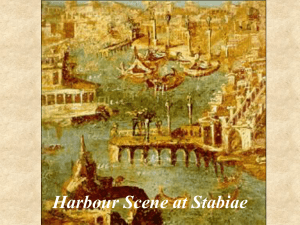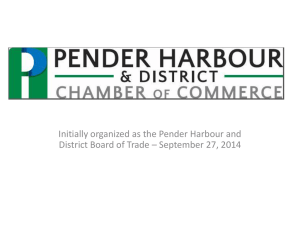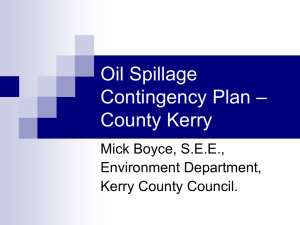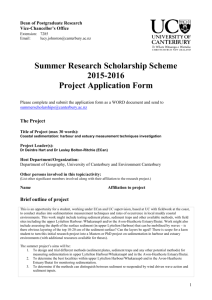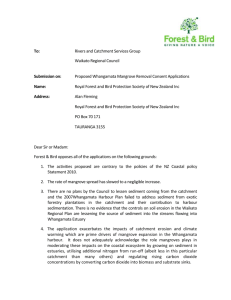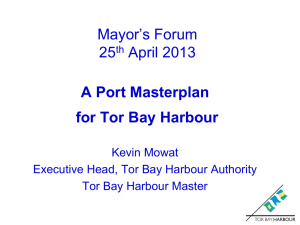Detailed Action Plan - Porirua Harbour Trust
advertisement
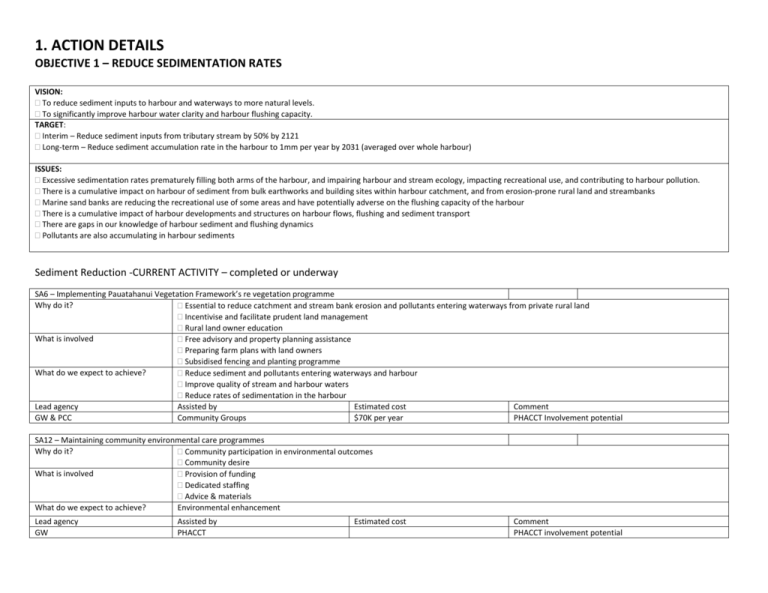
1. ACTION DETAILS OBJECTIVE 1 – REDUCE SEDIMENTATION RATES VISION: To reduce sediment inputs to harbour and waterways to more natural levels. To significantly improve harbour water clarity and harbour flushing capacity. TARGET: Interim – Reduce sediment inputs from tributary stream by 50% by 2121 Long-term – Reduce sediment accumulation rate in the harbour to 1mm per year by 2031 (averaged over whole harbour) ISSUES: Excessive sedimentation rates prematurely filling both arms of the harbour, and impairing harbour and stream ecology, impacting recreational use, and contributing to harbour pollution. There is a cumulative impact on harbour of sediment from bulk earthworks and building sites within harbour catchment, and from erosion-prone rural land and streambanks Marine sand banks are reducing the recreational use of some areas and have potentially adverse on the flushing capacity of the harbour There is a cumulative impact of harbour developments and structures on harbour flows, flushing and sediment transport There are gaps in our knowledge of harbour sediment and flushing dynamics Pollutants are also accumulating in harbour sediments Sediment Reduction -CURRENT ACTIVITY – completed or underway SA6 – Implementing Pauatahanui Vegetation Framework’s re vegetation programme Why do it? Essential to reduce catchment and stream bank erosion and pollutants entering waterways from private rural land Incentivise and facilitate prudent land management Rural land owner education What is involved Free advisory and property planning assistance Preparing farm plans with land owners Subsidised fencing and planting programme What do we expect to achieve? Reduce sediment and pollutants entering waterways and harbour Improve quality of stream and harbour waters Reduce rates of sedimentation in the harbour Lead agency Assisted by Estimated cost Comment GW & PCC Community Groups $70K per year PHACCT Involvement potential SA12 – Maintaining community environmental care programmes Why do it? Community participation in environmental outcomes Community desire What is involved Provision of funding Dedicated staffing Advice & materials What do we expect to achieve? Environmental enhancement Lead agency GW Assisted by PHACCT Estimated cost Comment PHACCT involvement potential Sediment Reduction- IMMEDIATE PRIORITY – Prioritised improvement to current activities or new activities within the next three years SB5– Develop a prioritised whole-of-catchment re-vegetation plan NEW Why do it? To identify and plan remediation of rural sediment sources What is involved ? Includes Expanded Pauatahanui Vegetation Framework’s protection and re-vegetation programme A focus on erosion-prone land and riparian protection and re-vegetation Animal pest and weed management by land-owners, councils, DOC etc Particular focus on sub-catchments with highest sediment loads- Horokiri, Pauatahanui and Porirua stream Implementation of the Whitireia, Belmont and Battle Hill Regional Park Sustainable Land Use Plans. Belmont plan will have significant impact on Cannon's Creek and Duck Creek What do we expect to achieve? Reduce sediment and pollutants leaving rural and urban areas Minimise future development impact on biophysical condition of catchment Lead agency Assisted by Estimated cost Comment Joint Land owners, DOC, PHACCT [$20Kapprox] PHACCT comment required on draft plan SB6 – Implement a targeted whole-of-catchment re-vegetation plan NEW Why do it? Remediation of rural erosion and sediment sources What is involved Implementation of a targeted whole-of-catchment re-vegetation plan A prioritised planting programme Landowner liaison and assistance towards retirement, fencing and planting where appropriate What do we expect to achieve? Reduce sediment entering waterways and the harbour Improvement to stream habitat Lead agency Assisted by Estimated cost Comment Joint Landowners, DOC, PHACCT, community gps 150K approx per year Involvement of PHACCT SB9 – Facilitate community environmental care programmes for priority locations Why do it? Recognised way to achieve cost-effective action on the ground Fosters community ownership Taps into community desire to be involved in protection and restoration What is involved Facilitating, supporting and supplying resources to community environmental care groups What do we expect to achieve? Increased vegetation cover around the harbour, streams and other priority areas of the catchment Improved litter management Reduction in sediment and contaminants entering harbour & waterways Lead agency Assisted by Estimated cost Comment Joint PHACCT & other community groups Within existing planned budget Involvement of PHACCT SB11– Plan and implement a public and business-specific education programme NEW Why do it? Improve community & industry awareness, understanding and appreciation of harbour & waterways Instruct community & industry about what it can do to help harbour protection & restoration What is involved Development of an education & awareness strategy/plan Maintaining or improving harbour web pages Specific education initiatives to be considered may include the following: o Sub-catchment stream adoption for primary schools o Monitoring and research programmes for secondary and tertiary institutions o Targeted training for businesses, home owners and developers o Community planting programmes o Workshops for recreational users o Regular catchment newsletters o Education initiatives coordination o Use and effectiveness of "Drains to harbour/stream" plates on street sumps. o Use of 'artistic' avenues to promote Strategy and its values What do we expect to achieve? Reduce urban, rural and industrial sediment and contaminants entering harbour & waterways Improve visual amenity of harbour, waterways and city Lead agency Assisted by Estimated cost Comment Joint PHACCT $50K (2011/12) plus $30K/yr Involvement of PHACCT (2012/13/14) SB12 – Prepare, distribute and promote public and industry guidelines NEW Why do it? Advise on particular issues impacting harbour originating from urban and rural activities What is involved Developing & distributing a series of targeted guidelines What do we expect to achieve? Reduce sediment, contaminants & litter entering harbour & waterways Lead agency Assisted by Estimated cost Joint PHACCT $30K + $5K/yr Comment Involvement of PHACCT but low priority Sediment Reduction - MEDIUM PRIORITY – medium term activities over next 4-10 years SC3 –Expand the ‘Muddy Waters’ sediment education programme Why do it? Raise awareness and understanding Stop sediment at source What is involved Targeted education programme What do we expect to achieve? Reduce sediment and contaminant sources Lead agency Assisted by GW PHACCT Estimated cost To be determined Comment Involvement of PHACCT through lobbying OBJECTIVE 2 – REDUCE POLLUTANTS VISION: Reduce pollutant inputs to, and sediment contaminants within, Porirua Harbour and tributary streams TARGET: Reduce faecal inputs so that 'Suitability for Recreation' beach grades improve to at least 'Good' Cap nitrogen levels in the harbour (i.e., no increase) Reduce toxicant levels in the harbour ANZEEC Sediment Quality Guidelines 'Low' thresholds, particularly from the Porirua Stream and Semple Street outfall Reduce harbour and stream litter ISSUES: Multiple sources of pollutants – sewer and stormwater infrastructure, industrial, rural and urban. Pollutants have the highest immediate impact on cultural, aesthetic and recreational values Particular litter challenges in Onepoto Arm Limitations on kaimoana gathering for areas subject to urban stormwater run-off PA14 – Maintaining a foreshore litter management programme Why do it? Litter management What is involved Supply and maintenance of harbour edge litter disposal facilities Regular targeted shore-edge clearance What do we expect to achieve? Reduction in foreshore litter accumulation Improved aesthetics Lead agency Assisted by Estimated cost PCC $15K/yr Comment Involvement of PHACCT Pollution Reduction - IMMEDIATE PRIORITY – initiate over the next three years PB8 – Increase targeted application of the ‘Take Charge’ programme to the Porirua Harbour catchment Why do it? Industries and commercial activities are a significant litter, sediment and pollutant source Improve compliance with regional rules for on site environmental management including discharges to land, air and water What is involved Business education and monitoring programme Targets pollution prevention, industry sectors and geographic areas What do we expect to achieve? Compliance with the regional rules for all discharges and cleaner production methods Reduce litter, sediment and pollutants entering harbour and waterways Lead agency Assisted by Estimated cost Comment GW PHACCT Staff time & travel costs Involvement of PHACCT through education PB9 – Develop and implement an education programme to reduce pollutant disposal into the stormwater system Why do it? Raise awareness of the impacts of stormwater pollution on waterways and harbours (e.g., paint or sump oil disposed into drains) What is involved Includes: Education kits Media releases to link domestic behaviour with harbour impacts What do we expect to achieve? Reduction in pollutants entering the stormwater network and then waterways and harbour Lead agency Assisted by Estimated cost Comment Joint PHACCT Within existing planned budget Involvement of PHACCT through “fish plates” programme OBJECTIVE 3 – RESTORE ECOLOGICAL HEALTH VISION: A significantly healthier indigenous habitat and better functioning ecosystems. Greater terrestrial, riparian and estuarine vegetation cover. More aquatic and indigenous avian biodiversity TARGET: Establish saltmarsh cover in all suitable areas of the harbour, especially in the Onepoto Arm Extend seagrass cover Increase riparian plant cover Extensive catchment vegetation restoration ISSUES: Adverse impacts of numerous hard edges on the estuarine plant environment. Unknown ability of seagrass to re-establish. Ecological Restoration - CURRENT ACTIVITY – completed or underway Ecological Restoration - IMMEDIATE PRIORITY – to initiate over the next three years EB2 – Prepare an estuary re-vegetation plan NEW Why do it? Provide coordinated framework for estuarine ecological restoration What is involved Engaging specialist consultant to prepare plan Includes consideration of harbour edge re-vegetation and restoration and SH1 lagoons restoration Environmental group liaison - PICT, GOPI, PHACCT Buffering the harbour from road and rail networks What do we expect to achieve? Agreed targeted and prioritised plan for estuary restoration activity Lead agency Assisted by Estimated cost Comment GW PCC PHACCT $50K Involvement of PHACCT through comment on plan EB3 – Implement an estuary re-vegetation plan NEW Why do it? What is involved What do we expect to achieve? Lead agency GW Assist estuary ecosystems restoration – improve marine and bird habitat Co-benefits as a filter of sediments and pollutants Improve harbour aesthetics Buffering the harbour from road and rail networks Implement a prioritised planting plan Planning nursery requirements Organising of community planting opportunitie Restoration of optimal estuarine vegetation cover Improved marine and bird biodiversity Aesthetic improvement Assisted by Estimated cost PCC PHACCT $50K/yr Comment Involvement of PHACCT EB4– Promote re-vegetation and new coast/estuary care groups targeted at the Onepoto Arm and catchment Why do it? Opportunity and need Public interest Consistency with GOPI/KPB work in Pauatahanui Inlet What is involved Facilitate and support new harbour-focused care groups Facilitate and support new stream care groups What do we expect to achieve? Cost- and time- effective planting and litter removal programmes Community engagement in harbour strategy and action plan Lead agency Assisted by Estimated cost GW DOC PHACCT Within existing planned budget Comment Involvement of PHACCT EB6 – Expand the three-yearly cockle survey to the Onepoto Arm NEW Why do it? ? Consistent approach to both arms of harbour A harbour health indicator What is involved Community field survey Data collection and analysis What do we expect to achieve? Monitor Inlet and cockle dynamics and health Inform harbour management decisions Comparisons between arms of the harbour Lead agency Assisted by Estimated cost PCC GOPI, GW PHACCT Cost to be determined Comment Involvement of PHACCT – discuss with GOPI EB7 – Prepare and implement a seagrass restoration plan NEW Why do it? Key element to marine species restoration What is involved Prepare targeted and prioritised planting plan Planting programme Community involvement What do we expect to achieve? Improved marine biodiversity Lead agency Assisted by Estimated cost GW PCC, NIWA PHACCT Cost to be determined Comment Involvement of PHACCT – trial first Ecological Restoration - MEDIUM PRIORITY – to initiate over the next 4 to 10 years or longer term EC2 – Design and build an estuary interpretation network, centre or kiosk POSSIBLE LONG-TERM OPPORTUNITY Why do it? Unique opportunity – similar facility unknown in New Zealand Educational and tourist resource What is involved Assess and recommend most cost effective opportunities, locations and option Construction and Development of interpretation material, design and installation Staffing Ongoing resourcing What do we expect to achieve? Public education – tell the estuary and strategy story – local interpretation of a global story Tourist attraction Environmental leadership Lead agency Assisted by Estimated cost Comment PCC, GW TROTR PHACCT $500K + $100K/yr Opportunity with Ngati Toa and PHACCT

